blog

This guy broke two diving world records and he only has one leg
“Scuba diving saved my life,” says cancer survivor Leo Morales. He’s living proof that diving is for everyone.Flying underwater – Leo's happy place.
On the shore of Mexico’s Playa del Carmen, 43-year-old Leo Morales does what he lives for: sharing the joy of scuba diving. But his scuba school has a particular focus.“We’re making diving accessible for everyone,” he says. “We focus on teaching people with disabilities, people who use wheelchairs, and also the visually impaired. We want to break the old concept that you have to be tough for scuba, that it’s better for men.
“The most incredible reward is the look in their eyes when they discover they’re free from the wheelchair, from the crutches, from having to drag their weight. You show people they are able to fly. They’re always so grateful.”Leo aims to show people with disabilities can do amazing things. Leo’s passion for diving began after a close call with cancer. He was 28 years old, enjoying a successful career as a bank manager. At the office one day he felt a strange pain in his back and went to the doctor. The diagnosis rocked him: he had a cancerous tumor growing on the inside of his right leg and buttock – it weighed 3kg and was two years old. Having the leg amputated was his only chance of survival. And even then, doctors said he would only live for another five years. After 12 hours of surgery, Leo woke up and looked down and saw flat bed sheets where his right leg had once been. Out of hospital he had to learn to walk again, how to use the toilet, get in and out of bed – everything was hard work. After losing his job for simply having a disability, Leo fell into depression. He felt like his life was over. But then a friend invited Leo to join him on a scuba dive. The first dive was “a nightmare”. Leo sunk to the bottom and fought with the water. On the second dive, his friend grabbed him underwater and swam along with Leo until he worked out how to propel himself. “That moment changed my life,” Leo says. “After that experience I became addicted to the ocean.”Now Leo is a dive master, scuba instructor and technical diver. And he also holds two world records: for the deepest dive (125 m) by a person with a disability and the longest dive (16km in 8h16m) for a person with a disability. His next goal is to set a world record for the deepest cave dive by a person with a disability. “The main point is to send a powerful message that people with disabilities are no different than people who are physically normal,” Leo says. “We can achieve amazing things with the proper training and equipment.”

Say namaste to the freediving island yogi
Kate Middleton lives on a tiny island in the Indonesian archipelago and spends her days exploring the ocean and doing yoga. The two “conscious practices” completely changed her life and her relationship with herself. Now she has nothing to prove.Kate teaches yoga and freediving on Gili Trawangan. © Kate Middleton
Before visiting the sun-spoilt shores of Indonesia, Kate Middleton was a hard driving overachiever. But there she became a yoga teacher and freediver, and it changed everything.
“Before, I had this drive to prove I was worthy enough by achieving different things,” says the 27-year-old. “It was super exhausting and it’s a vicious cycle because even when you do achieve things you always feel it isn’t enough and you need to do more.
“Now, I don’t do anything out of force or out of striving.”
Most days Kate trains and plays in the ocean. © Kate Middleton
With parents from Canada and New Zealand, Kate grew up between the rugged wilderness of Victoria, BC and the peaceful east coast of Auckland. As a teen, she struggled with eating disorders and low self-esteem, which led her to yoga as form of self-therapy. “It was my own secret practice,” she says, “and gave me a connection back to myself.”
After finishing high school, Kate went travelling and while in Bali she trained as a yoga teacher. She also trained as a scuba instructor, but soon found scuba didn’t satisfy a longing for a close connection to the ocean.Press play to listen to Kate's poem about why she freedives!
While in Bali, she visited Gili Trawangan, a tiny two by three kilometre island 35 km to the east. It was there she discovered freediving – and love. She met her business partner and boyfriend, fellow freediver and 13-time British record holder Mike Board. Kate expected to stay a few weeks, but eight years later they’re still there, running a retreat center, an organic café and a yoga and freediving school.Partner Mike Board is also a competitive freediver. © Kate Middleton
Kate likes to think of yoga and freediving as two among a number of “conscious practices” that are growing in popularity, along with an increasing interest in holistic, healthy living. For her, teaching both is a privilege.
“When teaching either there is a lot that comes up for students in terms of thoughts, beliefs and emotions, it's very psychological, so it creates an intimate connection between a teacher and a student,” she says. “Helping someone to learn to trust their body is such a special thing.”© Kate MiddletonKate is currently in the Bahamas competing in Suunto Vertical Blue 2016, perhaps the highest profile depth diving competition in the world. This week she set a new national record for New Zealand in the Constant Weight discipline by diving to 85 m, beating her last record by 10 m. In 2015, she won silver at the AIDA Individual Depth World Championships.
Hit play to find out more about Suunto Vertical Blue!
It might sound like she’s still an overachiever, but her motivation comes from a different place now.“I still enjoy progressing and challenging myself, but I’m also happy with where I’m at now,” she says. “Freediving and yoga are transformational. Both are tools that teach us to observe and return to the simplicity of the here and now, the fact there’s just one breath in this moment and you can always come back to it when you’re stressed.
“It’s amazing to witness how they both completely transform people’s lives.”
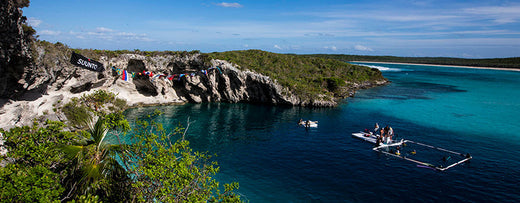
Freedivers ready to take the plunge at Suunto Vertical Blue 2016
36 freedivers from 20 countries are preparing for Vertical Blue 2016, the elite freediving competition held at the world’s deepest blue hole in the Bahamas. It starts on April 22 and runs for 11 days. Get a view from the inside here. Dean's Blue Hole has a depth of 202 m. © samovidic.com/ zooom.at
On the white sandy shores surrounding the deep, still waters of Dean’s Blue Hole waves of activity come and go.
Under the warm tropical sun, freedivers, competition judges, safety staff, photographers, media and organizers are preparing for Suunto Vertical Blue 2016, the most important depth diving competition of the year.
The athletes are putting the finishing touches on their training, or resting up and preparing their bodies with yoga and relaxation exercises. Diving down into the murky depths on a single breath requires total relaxation, which is more difficult to maintain under competition conditions.
Click here to learn about the different disciplines of competition freediving
Spectators look on as the competition gets underway. © samovidic.com/ zooom.at
Safety staff are busy finalizing protocols. Organisers are testing underwater cameras, including a new underwater drone that will follow each diver down and back again – a world first for a freediving competition.
We caught up with some of the players to give you a sneak peak behind the scenes.
The world champ
William is the first and only person to freedive to 101 m with no assistance. © samovidic.com/ zooom.at
Suunto athlete, world champion freediver, and competition host William Trubridge usually wins the top spot, which is more likely this year as his friend and rival Alex Molchanov isn’t competing this year.
The competition might still prove challenging for William.
“I've had a lot of recent injuries and sickness, so I am still not in top form,” he explains. “I'm treating this more as a warm-up competition for the season, but if I start doing good dives during the 11 days of the event then who knows?”
How deep do they dive? Click for a visual guide!
The island yogi
Kate runs a freediving and yoga school on an island near Bali. © katemiddletonyoga.com
Four weeks ago New Zealand record-holding freediver and yoga teacher Kate Middleton travelled from her tiny island home in Indonesia to tiny Long Island, the home of Dean’s Blue Hole, to focus on training for Vertical Blue 2016. The 27-year-old ocean lover is satisfied with her preparation.
“I’ve done all of the training that I can do beforehand,” she says. “Now I will benefit most from staying dry and resting up.”
For Kate, the competition is the pinnacle of the world’s freediving competitions. The professional organization, the robust safety system, the media attention and the level of competition make it special, she says. With no individual depth world championship in 2016, Vertical Blue is the most important competition of the year.
Read: The secret to freediving – relaxation.
Yoga helps freedivers to move fluidly and efficiently. © katemiddletonyoga.com
“All the activity is centred around the blue hole,” Kate says. “Pre- dive, most people are very quiet and focused. Post-dive everyone is really social and chatty. Everyone understands each other in that way. There's a lot of respect for where someone is at.”
Achieving her personal goals for the competition is one thing, but for Kate one of the main reasons she attends is for the community it offers.
“Freediving is a small sport so it’s rare that you're around so many people who have also devoted their life to this and to share something like that you really develop strong friendships quickly. Freediving brings everyone together.”
The judges
CarlaSue Hanson says its going to be a big 11 days. © Francesca Koe
President of AIDA International (Association for the Development of Apnea) CarlaSue Hanson is one of the judges at this year’s competition. To be a judge requires completing a specific AIDA course. Competition organizers pick judges according to their level of experience, something CarlaSue has in spades.
“The main responsibility of the judge is to ensure that all requirements of the rules of AIDA International are upheld,” she explains. “Safety is the main concern above all else.”
As AIDA president, CarlaSue knows many of the competitors.
“It does help to know the divers when tracking the results and also watching for any indications of stress or possible injury. I have a little record in my head about the past dives and it gives me some indication of what I might expect to see.”
Click to learn how to become a freediver!William Trubridge resting before a dive. © samovidic.com/ zooom.at
Like Kate, CarlaSue sees Vertical Blue as a prestigious event that attracts the world’s best freedivers.
“The unique setting and calm water of the lagoon provide for consistent conditions without excessive wind and current,” she says. “It’s also easier for all of us, as the competition site is so close to the shore so we don’t have to take a boat out to the venue.
“It is also one of the only competitions where we have spectators. The other athletes can watch their friends and rivals dive and we also have locals and tourists coming out to cheer and enjoy the competition.”
Chief of safety
Stephen Keenan runs a freediving school in Dahab, Egypt. © Francesca Koe
Competitive freediver and freediving instructor trainer Stephen Keenan is chief of safety this year. In previous years he has performed the role of platform coordinator so he knows well how to run a tight operation.
“My role is crucial to keep things running smoothly and to create a comfortable environment for the athletes to do their best,” he says.
Freedivers to watch
CarlaSue knows who’s who in the freediving world. She says there’s a lot of talent at this year’s event that she expects to do well.
Sayuri Kinoshita, Japan
“She won the overall women's gold medal at Vertical Blue 2015 and was also CNF gold medallist at the AIDA World Championship.”
Sofia Gomez, Columbia
At last year's competition she earned national records in the sport’s three disciplines: FIM, CNF, CWT.
Marianna Krupnitskaya, Russia
In 2014, Marianna was the world's number one ranked female freediver. Last year she became the Russian national depth champion.
Johnny Sunnex, New Zealand
Johnny won bronze at the AIDA World Depth Championship in 2013. He served as chief of safety at Vertical Blue 2014.
New to Vertical Blue
“We have some other athletes that are big names in freediving but are new to Vertical Blue: Aolin Wang and Jessea Lu of China, Italian Homar Leuci, Camilla Jaber from Mexico, Stephane Tourreau from France, American Ashleigh Baird and a local Bahamian Luke Maillis.”
CarlaSue expects many national freediving records to fall. At last year's competition 29 national records were broken by 12 freedivers.
Click here to read about last year's results and here to see this year's athletes.
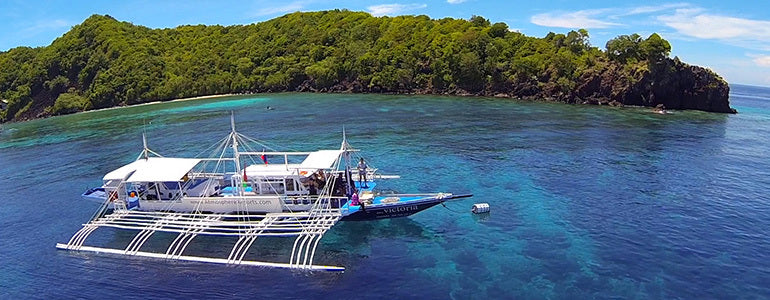
#DiveWithMe winner announced!
After a big response, we’re pleased to announce the winner of our #DiveWithMe contest – 24-year-old diver Theresa Torp! When she found out she’d won, her currently non-diving friend Anna immediately came to mind. The two have good times ahead! Theresa's dream is to swim with a whale shark. © Theresa Torp#DiveWithMe winner Theresa Torp and her friend Anna Sofie Starup have won an all-paid week-long trip to Atmosphere Resorts & Spa in the Philippines. The resort has a beautiful beachfront location on the island of Negros Oriental near Dumaguete. Anna will have the opportunity to complete a four-day open water diving course at the resort, and join her friend on some incredible dives. We asked Theresa about diving and why she picked Anna to join her. Congratulations! Feeling excited?
I can’t wait to experience the Philippines! The country has been at the top of my bucket list for as long as I can remember, and who knows, maybe I’ll get lucky and experience my first meeting with a whale shark as well!Theresa (left) and Anna (right) will travel to the Philippines this summer. © Theresa TorpSo, who is Theresa Torp?
I’m an occupational-therapy student and live in Denmark. When I’m not studying, I’m working my ass off as a sales assistant to save money for scuba diving and exploring the world whenever school “lets us off the hook”. When did your journey as a diver begin? Four years ago while travelling in Brazil I met the most amazing and inspiring people; a marine-biologist and a dive-instructor who didn’t consider scuba diving as just a hobby, but as a whole lifestyle and a big part of who they are. I was extremely fascinated about their way of living, and I’m pretty sure they’re the reason that scuba diving has become such a big part of who I am today.© Ulrika Kroon / Atmosphere Resorts & SpaYour most incredible dive experiences?
Every dive has it’s own story and it’s own memories, but some of my most memorable have been exploring the Cancún Underwater Museum, playing chicken with a huge and scary tiger shark at Cocos Island, rubbing a playful manatee’s belly in Crystal River, exploring enormous shipwrecks at Key Largo and kissing dolphins in the Bahamas. My greatest dream come true was diving side by side with hundreds of schooling hammerhead sharks at Cocos Island, about 550 km from the shore of Costa Rica.
© Bo Mancao Who is the lucky friend joining you? I met Anna Sofie at the first day of high school and we quickly became inseparable! A couple of years ago she moved to the other side of the country, but we stay in-touch and I still consider her as one of my dearest friends. When I heard about this amazing #DiveWithMe competition, she was the first and only person who crossed my mind! Not only will we get an opportunity to catch up in the most magical setting, I will introduce her to scuba diving, my biggest obsession. Even though I’ve experienced a lot of incredible dives, I’m certain that nothing could ever be compared to sharing it with her!
© Bo Mancao What would you like to show her underwater? That’s a difficult question as I’m looking forward to show her everything the ocean has to offer! I’m also really looking forward to show her the stunningly beautiful colours of the Coral Triangle and who knows, maybe I will get to share my first meeting with a whale shark with her – that would be a big dream come true.
Is she excited about the trip and learning to dive? I’m not sure if I’ve ever seen her more excited! Anna is one of the most joyful and adventurous people I’ve ever known and I’m sure that she’ll turn out to be an amazing scuba diver and dive buddy. Just as I’m sure that this trip to the Philippines will turn out to be an adventure of a lifetime!Lead image: © Ulrika Kroon / Atmosphere Resorts & Spa
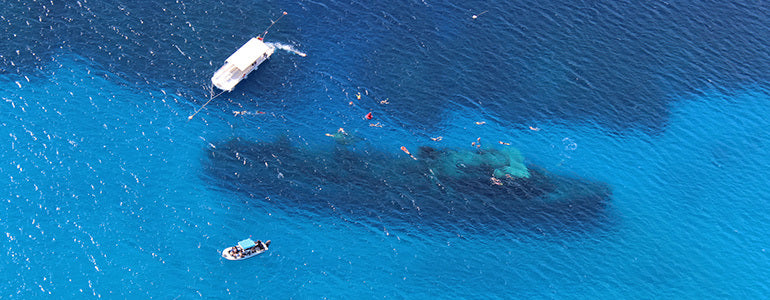
7 incredible shipwreck dives
For divers, nothing quite beats the experience of a wreck slowly coming into view as you descend into the deep. There is a sense of wonder at the fallen grace of a once great ship, and a feeling of awe at the loss of life. They are also often fantastic dive locations, having evolved into artificial reefs, attracting abundant sea life. Here are seven of the best.
U.S.S. Kittiwake, Grand Cayman Great for: wreck rookies
One of the most popular and accessible wreck dives around the world, the 76.6m long Kittiwake was purpose sunk off Grand Cayman’s Seven Mile Beach just a few years ago. It’s also been stripped clean of hazards such as doors and hatches. All five levels of the ship can be penetrated, depending on the certification you have.
Rainbow Warrior, New ZealandGreat for: Politically motivated divers
When French secret agents sunk the Greenpeace vessel in Auckland harbor in 1985, it caused a huge political scandal. Two years later the ship was scuttled at Matauri Bay in the Cavalli Islands to serve as a dive wreck and artificial reef to promote marine life. At a max depth of 26 m the Warrior is now home to a huge variety of aquatic life and is a world renowned dive site.
Bell Island, NewfoundlandGreat for: Adventurous divers
Bell Island is one of the few locations in North America that was under attack by German forces during the Second World War. In 1942, U-boats raided the island twice, sinking four iron ore carriers and destroying a loading wharf, killing more than 60 men. “Today, divers visiting Newfoundland’s rich waters can dive these remarkable wrecks that have transformed into stunning and colorful reef structures,” says underwater explorer and Suunto ambassador Jill Heinerth. Check out the video she created here:
‘Badewanne’, Gulf of FinlandGreat for: Undiscovered wrecks
Numerous wrecks lay on the Gulf of Finland’s sea bed, from 17th century merchant ships to battleships and submarines from the first and second world wars. During the latter, German sailors dubbed the Gulf of Finland ‘badewanne’ or bathtub. Today it’s the name of a team of Finnish explorers, scientists and historians dedicated to finding and preserving lost wrecks such as Torpedoboot T18. But if you’re hoping to dive there yourself, bad news: the team does not release the site locations to preserve their integrity.
Chepstow, EnglandGreat for: Underwater attractions
How can a lake on the border between England and Wales be home to a great bucket-list wreck dive? That was our question too. But after watching the video below from freediver Daan Verhoeven diving through a sunken plane, we think you’ll also want to add this venue to your list. The lake is home to a number of attractions, including a Landrover, Royal Navy Wessex Helicopter Mk3 and a British Aerospace Jetstream 200. There’s also a gnome garden if you’re into that.
HMS Hermes, Sri Lanka Great for: Sea life
Lying at a depth of 53m off Sri Lanka’s east coast is the Royal Navy Aircraft Carrier HMS Hermes, the first ship to be designed as an aircraft carrier. It’s a unique dive. She lies on her port side with many features still intact, including her tower and thanks to clear visibility you can also expect to see large tuna, grouper and jacks. Watch a video of a dive here:
The Yongala, Australia Great for: Visibility, sea life and features
At 109m, the Yongala is Australia’s largest and most intact historic shipwreck and offers incredible diving within the world heritage Great Barrier Reef Marine Park. She sank off the coast of Queensland during a cyclone in 1911, killing 122 people, a racehorse called Moonshine and a red Lincolnshire bull. With no telegraph facilities, she could not be forewarned of a storm. Expect to see abundant sea life including manta rays, sea snakes, octopuses, turtles, bull sharks, tiger sharks, and of course, some beautiful coral.
Lead image: This photo, “USS Kittiwake”, is copyright (c) 2013 to KatieThebeau and made available under an Attribution-Noncommercial-Share Alike 2.0 license.
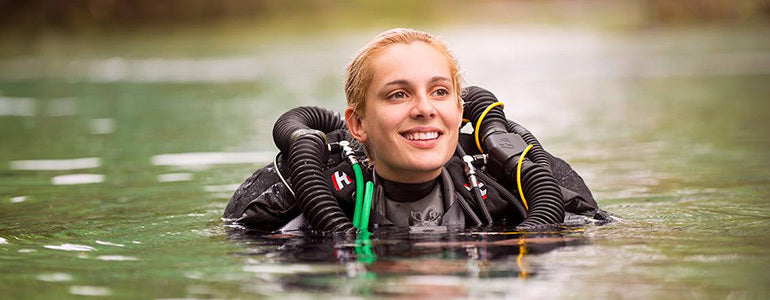
How to take your diving to the next level
So, you’ve been diving for a while now and have noticed that you’re itching for something new or more challenging – that’s a sign it’s time to take your diving to the next level. We talk to 25-year-old technical diver Gemma Smith – the first woman to dive the ancient Antikythera shipwreck – about how to step up your diving.
© Nina Baxa
Before Gemma Smith started diving when she was 17 she’d been into a number of extreme sports. “Then I discovered scuba diving, and that was that!” she says. We caught up with her a day before she set off on an intense three months of diving, including cave diving in Florida, mine diving in Newfoundland and shark diving in the Bahamas. Here are her 7 pointers for how to take your diving to the next level.
It’s not just about depth or difficulty
Even though I'm known as a technical and re-breather diver some of my best dives have been on a single tank and in 10 m of water! Diving with silversides in Grand Cayman was truly out of this world, yet I never went below a few meters. Having said that, cave diving is where my heart is. When you're on a re-breather 2 km into a cave, gliding along on a DPV (diver propulsion vehicle), I'm not sure anything can top that.
“Some of my best dives have been on a single tank and in 10 m of water!”
Build your motivation
One of the things I like most about diving is there’s always something new you can challenge yourself with. As long as you have the motivation and dedication to pursue different avenues and try new things, you'll never get bored and never feel like you're not improving.
© Nina Baxa
Patience and hard work are mandatory
The first thing to remember is to be patient. Taking your diving to the next level won't come quickly, it won't be easy, but it will totally be worth it. You've got to be prepared to give up a lot, and to work hard.
© J. Dan Wright
It’s all about the people
You will also need to make the effort to meet people. The diving world is really small, and – especially with the expedition scene – it helps if you know the guys involved. You need to try to stand out, and that requires effort. Spend the money and train with the best people out there. I've trained with some truly amazing instructors; Martin Robson, Rich Walker, Paul Toomer, Ian France. The things I learned from them have allowed me to take my diving to the next level.
“Spend the money and go to train with the best people out there.”
Change in outlook
Changing how you see your diving is really important if you want to take it further. I love my diving, and I'm so glad I've chosen it as my career, but nonetheless it's my job, and I treat it as such. I don't see it as my hobby.
© J. Dan Wright
Make an investment
You also need to realise that if you want to advance your diving it will require a big investment, both financially and in terms of time. I always compare it to university. I chose not to go, but I've invested the same time and money in diving. You need that mind-set I think if you want to succeed.
“I always compare it to university. I've invested the same time and money in diving.”
Practice, practice, practice
Practice. On every single dive you need to practice skills, preferably two. So many people do courses, and then never practice any of the skills they learned. Have fun, enjoy it, but take it seriously. It's the only way to improve.© J. Dan Wright
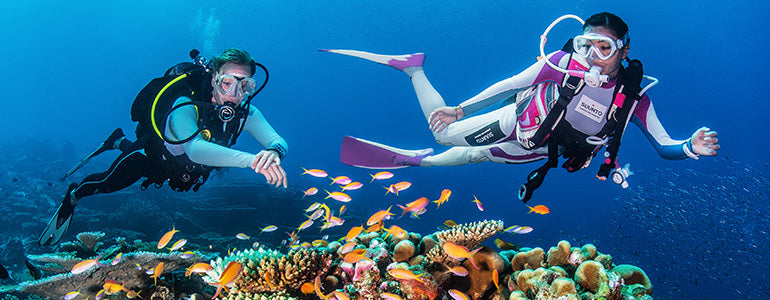
A pro diver’s essential tips for newbie divers
Teaching the joy of diving is Marco's passion. © atmosphereresorts.com
Diving isn’t an extreme sport
The classic newbie misunderstanding is thinking that diving is an extreme sport. Often they think it’s a very physical sport, but the opposite is true; diving is a very relaxed activity. Water is much denser than air, and that’s why we need to move slowly and be streamlined all the time. Once I taught a yoga teacher and after the dive she said, “being underwater is similar to a yoga class”.
Different strokes for different folks
Every person is different. One person, for example, needs much more time to get the buoyancy right, while another needs less (buoyancy is difficult in the beginning, but gets easier with practice). It’s important to be patient and to find an instructor you’re comfortable with so you can relax.
© Bo Mancao
Get in shape
You don’t need to train specifically to become a diver, but it’s helpful to be in good physical shape and a strong swimmer. Before you start your course, you need to sign a medical questionnaire to make sure you are fit to dive.
One step at a time
Don’t rush in and buy all the gear immediately. Give it time to make sure you really want to commit to diving. I highly recommend buying your own dive mask, however, because every face shape is different and it’s important to be comfortable. You can use it for snorkeling, too. If you decide diving is for you, then it makes sense to buy your personal dive gear. But go step by step.
© Bo Mancao
Follow the stars
Choosing the right dive center to learn at is important. It’s best to find a five star PADI center. Taking an online diving course is a great idea too so when you finish your studies online you can focus on the practical side of things.
Dive into open water
So, you’re 100% into diving! Time to complete an open water diving course! If you finish the theory online beforehand, an open water diving course can be completed in two to three days. With the theory included, it takes between three to four days. Don’t rush it. The instructor needs to make sure the students are ready. Following this is the advanced open water diver course.
Click to see the new Suunto Zoop Novo Blue*!
© Bo Mancao
Find a dive buddy
You should never dive alone. It’s safer and more fun to have a dive buddy, someone you trust, and whose equipment you’re familiar with. Diving is a very social activity so finding a buddy won’t be hard. You usually dive with someone you meet on a boat, at a resort, or in a dive shop. It’s important you speak about the dive and equipment before you take the plunge together.
Working with fear
Experiencing some level of fear is a very common experience for newbie divers. I was really afraid when I did my open water course. That’s when a good instructor can make all the difference. If the instructor is calm and gives the student time to adjust – because his or her brain is overloaded with new information – they usually work through it.
Marco won't be giving up his day job anytime soon. © atmosphereresorts.com
Keep diving!
Most people dive just for fun so they mainly dive when they’re on vacation. How often you dive depends on your personal goals, but diving once or twice every six months or year is a good idea so you avoid losing skills and familiarity.
*Suunto has just released the Zoop Novo Blue, a dive watch perfect for beginner divers or people seeking new adventures. Click here for more info about this simple to use dive computer.
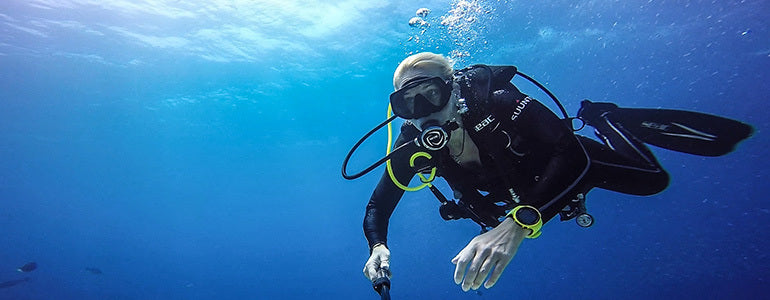
How to start diving
The famous Scuba Diving Girls Margo Sanchez and Stephanie Adamson are long-time champions of exploring the ocean. The Californians constantly share images and clips of themselves diving with playful seals, baby rays, turtles and sharks. Who better to ask how to start scuba diving?
© scubadivergirls.com
What do you say to someone thinking about diving for the first time?Just go for it. There is so much to see and experience with scuba diving. Don’t be afraid of all the gear, you will quickly get used to it and be empowered by it. There is really nothing that compares to this experience and you will not only love scuba diving, but also you will fall in love with a world unknown to you now.
“When you find a connection with the ocean and its inhabitants, it is a feeling you cannot ignore.”
What do you wish every newbie diver knew?
Have fun! Diving will bring so much joy to your life so remember to enjoy it. Make sure you find dive buddies who enjoy the experience and enhance your experience. It is important to follow your instincts and don’t let others intimidate you.
Click to see the new Suunto Zoop Novo Blue*!
© scubadivergirls.comWhat path do you recommend?Depending on your experience in the water, it may be good to try out scuba first. There is a class offered by most dive shops and independent instructors called Discover Scuba. This allows you to get in and get some instruction and try out the equipment before committing to a full certification class. But if you know you are ready, then it is time to sign up for an open water diving course.
“There’s nothing more memorizing than watching a shark glide by silently and unexpectedly or a seal who comes to pull on your fin as you frog kick your way through a kelp forest.”
What are the key steps to becoming a diver?
Finding a good instructor that you feel comfortable and safe with is the first step. Learn the skills and safety procedures during class and practice as often as possible. Even after you are certified, you should continue to practice the skills on a regular basis, as this will make you a better diver. Get as much time in the water as possible. Find buddies who are more advanced than you so that you can learn from their techniques. Don’t be lazy when it comes to your equipment care and maintenance. Your equipment is your lifeline.
© scubadivergirls.comWhat are the important things to remember? Safety should always be your first priority. It takes many dives before you are skilled enough to deal with the many issues you can experience under the surface. Understand your limits and never dive beyond these limits. If you want to do more advanced dives, take the classes to certify in that discipline first and even then be sure the diving is within your physical capabilities. When diving a new place find a local dive expert to guide you. Be sure you understand your gear. Diving should be super fun but always be sure safety is your primary focus.
*Suunto has just released the Zoop Novo Blue, a dive watch perfect for beginner divers or people seeking new adventures. Click here for more info about this simple to use dive computer.
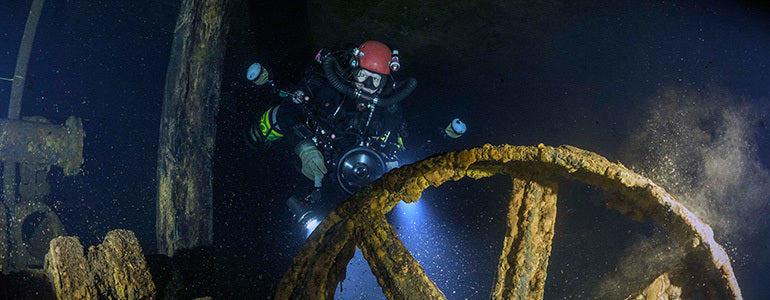
Diving in the abandoned Bell Island mine
It’s the Royal Canadian Geographical Society’s Expedition of the Year – the Bell Island Mine Dive. Suunto ambassador Jill Heinerth is part of the team exploring the vast and submerged mine system. Scroll down to learn more and to see images of this incredible dive site.
Canadian underwater explorer and technical diver Jill Heinerth is part of a team now exploring 100 km of long-abandoned mining passages beneath the seafloor of historic Bell Island, which lies off the coast of Newfoundland, Canada “The plan is to open this site for guided cave diving for experienced divers,” Jill says. “Ocean Quest Adventure Resort already boasts the ‘Truk of the North’ in terms of shipwrecks. Couple that with the mine, icebergs and humpback whales, and you have one of the finest diving destinations on the planet.”
“Shipwrecks, the mine, icebergs and humpback whales – one of the finest diving destinations on the planet.”
© Cas Dobbin 2016The plan for the expedition is to establish some primary guidelines for others to follow in the future and to get an idea of what was left in the mine when it was abandoned in 1966. So far, they have found everything from the remains of a miner’s lunch kit, an antique Pepsi Cola bottle, to large pumping equipment and pressure dampeners. “The walls of the mine also tell an important story; miners left behind basic graffiti on the walls such as columns of addition but also painted caricatures in lampblack and white crosses where their colleagues died. It all tells the anthropological story of mining.”
Click for more about Jill Heinerth
© Cas Dobbin 2016The expedition will also explore the island’s staunch local culture and WWII shipwrecks in its harbour. “The high-grade ore coming from the Bell Island mine was critical to shipbuilding during the war,” Jill says. “In 1942, a German U-Boat sunk four ore carriers and blew up the loading wharf on Bell Island. Seventy men died. The four shipwrecks are a part of this project and I will be back to document them in summer.” © Cas Dobbin 2016Engineers have helped the team assess and mitigate risks in the dry part of the mine. The hematite ore walls can collapse simply by leaning against them. Underwater, they have experienced whiteout conditions from inflowing meltwater. The remaining electrical supply line is an entanglement hazard. “We have to employ very prudent and conservative diving protocols to keep everyone safe and that means a big team topside to help in the logistics and safety.”
“It all tells the anthropological story of mining.”
The team includes some of the best technical divers in the world. Most are from Canada, and two others are from Britain and Germany. “The majority of the team is using rebreathers in order to lessen the impact of percolation from the ceiling and to increase warmth and comfort.”
Click for 7 off-season tips for divers
Fierce weather has created problems for the expedition. Blizzards, gales, floods and complete melts have each made things difficult. “The weather made travel across the Tickle to the island impossible on some days and on others we had a river of rushing meltwater flooding the infrastructure we had built for the project. It has not been easy, but we are learning about the forces of nature that will affect further exploration here.”
To follow news about the Bell Island Mine Dive expedition, click here.
Main image: © Cas Dobbin 2016
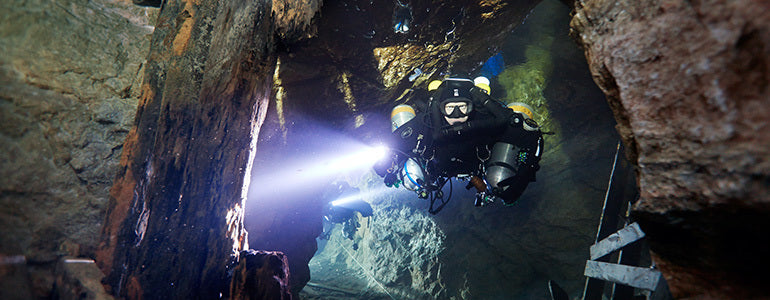
7 off-season tips for divers
Technical diver and commercial dive supervisor Andy Torbet began exploring the ocean when he was 12 and has been at it ever since. He’s explored sunken cities, elaborate cave systems, deep wrecks and reefs. We caught up with Andy just before he left for an expedition and asked what divers should do to stay dive-ready in the off-season. Here are his 7 off-season tips.
Don’t have an off-season
My personal recommendation for the off-season is not to have one. Even if you dive only very occasionally, and the dives are shallower and shorter than normal or even in a pool, it will help. They will keep those essential skills from fading and make sure your kit is working and familiar. Most diving incidents and accidents happen every year in spring when people come back to diving after taking the winter off. Just a quick dive a few times over the winter will help you stay on top of your game.
Andy explores Finland's Ojamo Mine, where Suunto tests its dive products. © Janne Suhonen “Most diving accidents happen in spring when people come back to diving after taking the winter off.”
Diving’s not physical, but it’s also physical
Diving is not primarily a physical performance sport but it is still physical. Recent medical investigations supported by incident reports have shown that your body is put under pressure even on simple dives and the more physically robust we can make ourselves the safer we are.
Why fitness matters
Ask yourself this: if two divers had identical diving skills, experience and attitude would you rather dive with the fit one or the out of shape one? Which diver do you think would have the greater chance of having a problem and which would you rather count on? Being physically fit can help in nearly all situations and is particularly important in some situations, from finning against a strong current, towing a casualty on the surface or just hauling oneself out of the water in a less than ideal condition. “Being physically fit can help in nearly all situations.”
© Martin Hartley
Take care of your body
It’s worth keeping a basic level of activity going in the off-season to keep you healthy for the new season. I know a lot of divers who go hill walking in winter just to keep their bodies active. But it’s also a time to look at doing some work on those problem areas you’ve been putting off (because you were too busy diving). Perhaps it’s a sore shoulder or a weak knee. Make sure you start the new season in the best shape possible. That way you can dive more, enjoy it more and be capable of more.
Core strength is key
Diving kit is heavy so spend some time working on your strength, and especially core strength. I’ve seen a number of dives cut short because someone injured their lower back getting kitted up. You can spend the spare time in the off-season getting into the habit so when you start diving again these exercises have become part of your routine.“I’ve seen a number of dives cut short because someone injured their lower back getting kitted up.”© Janne Suhonen
Maintain and take stock
I don’t have an off-season, but the winter is less busy so I use that period to service equipment, look at what needs replacing or go over the last year and see what I could can change or improve for next year. It’s an opportunity to take stock and look to improve.
Stay inspired
Keep yourself inspired. The off-season is also a good time to start planning projects or booking those courses you want to get done. Get the paperwork side of things done when the weather is bad to make full use of your time when it’s time to start diving.
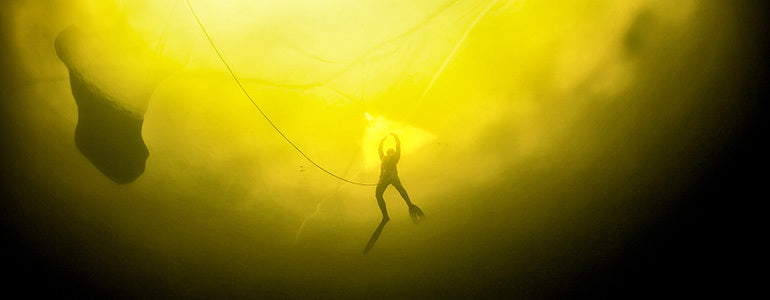
Four reasons to try ice diving
Usually freediving events are held in warm and sunny locations like Dean’s Blue Hole in the Bahamas, but not Asikkala on the Rocks. It’s held every March in Finland and involves plunging through a hole in a sheet of ice and diving down into the biting waters beneath. Pure madness, you think? “Not at all,” says organizer Antero Joki, Finland’s top freediver. “It’s a spiritual feeling. It’s not about how deep you go, it’s about the feeling.” Here’re four reasons to give ice freediving a go.
Feeling brave? Jump in in your swimsuit. © Pekka TuuriThe thrill of the cold Despite what you might think, diving in frigid water doesn’t feel terrible once you get past the initial shock. “It’s actually thrilling,” Antero says. “Every time someone overcomes their fear of the cold and goes for it, they come out of the water smiling. Of course you can feel the coldness through your wetsuit, but it’s not bad. You can stay in only for half an hour, but that’s enough to enjoy this incredible underwater experience.”
“Every time someone overcomes their fear of the cold and goes for it, they come out of the water smiling.”
© Pekka Tuuri
The underwater ambience
“It’s hard to describe this; you have to experience it for yourself,” Antero says. “There’s total silence. There’s this twilight light and the ice creates a shadow theater. You can see shadows of the people moving on the surface of the ice. And even though it’s cold, it feels cozy.” It teaches relaxation “It’s always a maximum of 4°C below 10 m so it’s always cold and it’s always dark,” Antero says. “But when you learn to relax in a cold and dark water it means when you freedive in warm water it’s so much easier to be relaxed.”
© Pekka TuuriThe Finnish saunas Before plunging through the ice, Asikkala on the Rocks participants relax in saunas to prepare themselves and then again afterwards to warm up. “The combination of warmth and cold is good for body and mind,” Antero says. “It’s a very relaxing atmosphere.”
MAIN IMAGE: © Pekka Tuuri

7 incredible places to snorkel that you can access from the beach
Here’s one of those vacation bugs: great beaches often have lousy snorkeling. You wander into the sea hoping for pristine waters and a vibrant underwater life and what you get is cloudy visibility thanks to all the sand – and zero fish. But you don’t have to join a boat trip to that ‘hidden’ cove to enjoy great snorkeling. Here are seven beaches you can take both your book – and your fins.
Ayada Maldives
The Maldives is home to some of the best diving and snorkeling around the world; an abundant sea life, clear warm waters and some fantastic beaches as well. Where to stay? We’re biased but last year the Suunto Dive team stayed at Ayada Maldives. The house reef is just a few minutes swim from the beach and home to reef sharks, rays and sea turtles. You’ll love these incredible underwater shots.
© George Karbus
Dean’s Blue Hole, Bahamas
Dean’s Blue Hole is the well known venue for some of the world’s deepest freedives. One of the world’s largest salt water blue holes, it plunges down to 200m just meters from the soft sanded beach. But you don’t need to be a champion freediver like Will Trubridge to enjoy the venue. Diving down to the entrance rim of the blue hole is within reach of most people, while there’s great snorkeling to be had around the cove.
© samovidic/ zooom.at
Goat Island, New Zealand
Let’s be honest, New Zealand is not the first place you’d think of for a beach and snorkel vacation. But as the country’s first marine reserve, Goat Island is a surprisingly awesome and family-friendly venue for sun and sea worshipers. Approximately 90 km north-east of Auckland, the reserve is home to snapper, kingfish, kahawai and jack mackerel. Lobster and crayfish are also common while seals and dolphins are also occasionally spotted.
Okinawa Island, Japan
Move over Great Barrier Reef, Thailand (see # 6) and Bali. If you’re looking for awesome snorkeling within reach of some pristine sandy beaches, head to Japan. We asked freediver Tomoka Fukuda for her recommendations. Unsurprisingly, she went for her home. “The Okinawa ocean is very beautiful,” she says. It’s also home to turtles, manta ray, reef shark and an abundance of other tropical fish. The sushi’s pretty good too.
Noa Noa Island, Philippines
It sounds like it could be the lair of a Bond villain, but there will only be pleasant surprises for those who visit the private island of Noa Noa. An official marine sanctuary, it is surrounded by a 70 hectare tropical reef. It features easy beach access, areas suitable for beginners as well as caves and walls for those adventurous snorkelers who want to explore further.
© noanoaisland.com
Phuket, Thailand
We tried really hard not to mention Thailand but some places you just can’t ignore. Among them are the many beaches in Phuket. Some offer better snorkeling than others. Find beautiful coves and rock formations at Ao Sane beach in the south-west.
Raja Ampat Islands, West Papua, Indonesia
If it’s unparalleled snorkeling and biodiversity you’re after, you’ve come to the right place. The Raja Amapat Islands of West Papua are home to 75% of all known coral species and abundant marine life. There are over 1,000 different species of fish in the reserve. Expect to see sea turtles, sharks and manta rays, and because it’s so remote, very few people. The catch? Access is also remote. There are some incredible beaches with snorkeling just a few steps away, but you may need a boat to get to the beach first. © Trekpedition.Com via Flickr
MAIN IMAGE: © Predrag Vuckovic

New software 1.5.9 for Suunto D-series dive computers
Suunto, the world’s leading dive computer brand, introduces an optional software update bringing usability and performance improvements to the Suunto DX, Suunto D6i, Suunto D6i Novo, Suunto D4i and Suunto D4i Novo.
Suunto's D-series dive computers are known for their refined design and solid functionality. The new software update 1.5.9 builds on consumer feedback and makes the devices even more user-friendly whether you're an experienced technical diver, freediver or an adventurous spirit new to the diving world.
The new enhancements include:
The dive mode selection is moved to sub menu ”General Settings” to make it easier to change and dive with the desired mode.
Easier and quicker digital compass calibration brought to D6i (similar to the DX) adds the possibility to calibrate the compass also underwater.
Stopwatch usage simplified.
Enhanced battery and pressure sensor checking.
This optional software update is available to existing Suunto DX, D6i and D4i owners via Authorized Suunto Service Centers. Please note, Suunto authorized battery change points are not able to offer this software update. When you send your dive computer for servicing or a battery change, the software will be updated at the same time without an additional cost. Without a battery change or other service procedure the cost is a handling fee that varies from country to country. D4, D6, D9 and D9tx can not be updated – you can identify the model on the backplate of your dive computer.
Please contact your local Suunto Dealer or Suunto Contact Center for more information. For contact details and updated user guides check out support. You can also check out the D-series learning tool or visit the Suunto YouTube channel for how-to-use videos.

Diving between tectonic plates
Underwater explorer and Suunto ambassador Jill Heinerth has dived in breathtaking locations all over the world so when she says one place has the clearest water and is the most inviting it’s worth sitting up and paying attention. It’s time to update your bucketlist. Located in Iceland’s Thingvellir National Park is the most impressive meeting place of the North American and Eurasian tectonic plates – the Silfra fissure. The two plates drift apart about 2 cm every year and snorkelers and divers can swim between them in the fissure and even touch the two continents at the same time – the only place in the world this is possible.
Intrepid underwater explorer, photographer and film maker Jill Heinerth dived there in 2014 with scientist Jónína Herdís Ólafsdóttir who is researching the unique bacterial colonies that live in the Silfra and in other fissure cracks around Iceland. The research may offer insights into early life on Earth and possibly about life on other planets. While exploring there, Jill captured some amazing images of Jónína swimming in the fissure. Prepare to be amazed.
The Silfra fissure from above. © IntoThePlanet.com – Jill Heinerth
100 m visibility
The underwater visibility in the Silfra fissure is over 100 m. This is because it’s cold (2°C – 4°C year round) glacial water that's filtered through lava for 30 to 100 years before seeping from underground wells into Thingvellir Lake. It’s so pure it’s fit to drink. “Diving or snorkeling in Silfra should be on everyone's bucket list,” Jill says. “There’s simply no other water on this planet that is as clear and inviting.” © IntoThePlanet.com – Jill Heinerth
Diving into creation
The Silfra fissure has four sections that can be explored: the Silfra Big Crack, the Silfra Hall, Silfra Cathedral, and Silfra Lagoon. “Drifting through the gap in the tectonic plates in the middle of this gusty, raw and primordial environment makes you feel like you are diving into creation itself,” Jill says.
© IntoThePlanet.com – Jill Heinerth
The home of adventure
“Iceland is a stunning and unique environment,” Jill says. “The people are warm and the geography is absolutely incredible. For those that love the wildness of outdoor adventure, there is nothing like it.”© IntoThePlanet.com – Jill Heinerth
Discovering the earth’s last hidden frontiers with Phil Short
Phil Short has been a dive industry professional for over 20 years. He has explored some of the world’s deepest dry caves and spent thousands of hours diving water filled passages. Research and archeology are also his passion, including such assignments as the Antikhytera survey project in Crete. But what is down there that draws Phil to explore these submerged realms?
Cave diving is the last field where human beings are mandatory for exploration. In Victorian times, when somebody climbed a mountain, that was it. They were the first. Now technology has taken over. You can take a look at a picture of a mountain, a valley, jungle, or a gorge before you go there. It has been all mapped.
“When you get to the end of the line in a cave, tie your line to that line and swim around the corner, you're the first human being there. It's true exploration, much like Shackleton, Scott and all of these early explorers did because there was no choice. In cave diving, there's still no choice, and that's why I’m so passionately driven by it. Anyone with a sensible budget can find new territory.”
THE CAVE DIVING ROCK NERD
Millions of years ago, the seas were filled with very different kinds of life forms than today. Over the millennia, soft seafloor turned into limestone, preserving a snapshot of these creatures from the past. Caves cut right through these ancient layers, displaying a rich collection of fossils and telling a geological story of the Earth’s past.
Phil Short has dived caves all over the world, spending thousands of hours diving exploring many kinds of dry and water filled passages. He knows that seemingly small details hide countless stories. Taking a close look, a bulge in the cave ceiling can turn out to be a tooth of an extinct tiger.
“Think about swimming through 100 metres of cave passage today, and memorise all of it. And then get into a time machine and go 3,000 years into the future. The cave would be different because you're diving in something that is alive. The acidic rainwater is dissolving rock, and the flow of the water is eroding it. So the cave is growing. It's forming. It's changing as you're swimming through it.”
SETTING THE PERSONAL LIMITS IN CAVE DIVING
Cave diving requires rigorous training and the right equipment. But there also needs to be the correct mentality and respect for the forces of nature. Constant practise and safety margins are the cave divers tools for keeping the risks at bay.
Phil Short has been a dive industry professional for over 20 years. He has trained hundreds of divers and participated in demanding cave rescue operations. With the experience of thousands of dives, he knows where to draw his line.
“I don't consider cave diving an adrenaline sport. In fact, it's the opposite. Going to an extremely deep point in the ocean, just to get a number for a depth record, that is not my motivation. I would happily do, and have done a lot of very deep dives, for a reason such as a historic shipwreck that nobody's managed to dive. I have more of a kind of Peter Pan, never grow up, child-like approach to exploration. Being there is just magical. It's my drive.”
GUIDING STAR – A YEAR OF UNDERWATER ADVENTURES
“There is something special about the connection between women that cannot be explained with words alone. It is that deep feeling of affinity we have that brings us close and sets a common understanding of what we experience in our life’s triumphs and tribulations. It is a connection only a woman can truly understand. That is what makes the Suunto Jewel so special. The very essence of its existence and what it represents, expresses that unspeakable bond that brings us together,” the Scuba Diver Girls say.
Last February, Suunto sent three Suunto Guiding Star pendants on a journey around the globe. The pendants were passed from one adventure-minded woman to the next, travelling from the Alps to the Arctic Lapland and onwards, and from the Pacific Ocean to icy waters in upstate New York and back under the Caribbean Sun.
We have been following the journey of one pendant in particular, as it was passed on among some of the world’s most inspirational female divers. Here is an account of that journey, told by the divers themselves. While the list of adventures and places the jewel has seen is impressive, what strikes as most extraordinary, is the invisible bond of sisterhood the jewel has created between these women.
The journey took off in the Maldives, where Scuba Diver Girls Margo Sanchez and Stephanie Adamson were the first women to wear the jewel. The jewel spent some memorable moments diving in the crystal blue waters around Maguhdhuvaa Island and later on travelled with Margo and Stephanie back home to San Diego, United States.
“The jewel came with us into our beautiful backyard, an ocean full of kelp, sharks, turtles and a myriad of other amazing sea creatures,” Margo describes. “After a few weeks of enjoying our precious piece of art, it was time to pass it along.”
Scuba Diver Girls chose to give the jewel to Becky Kagan Schott, the Emmy Award winning underwater videographer, photographer and tech dive instructor.
“Becky embodies an amazing spirit that every woman should embrace. We passed our jewel on, holding it tight as to pass on our energy with it. By now it has traveled the world and laid over so many strong women’s hearts. The energy it possesses is most certainly magical,” Margo writes now, looking back to that moment in February.
One of the strong women to hold the Guiding Star next was Jill Heinerth, the underwater photographer and film-maker specialized on demanding cave exploration and 3D imaging. She took the jewel on a National Geographic cave diving expedition in Cuba, where she conducted exploration and survey dives, working with climate scientists and paleontologists:
“My job was to photograph and video our work and also deploy an exciting 3D imaging technology. I was able to take numerous calibrated photographs that were assembled into a 3D model of some of the paleo animal artifacts inside the cave,” she explains. “These files were merged into an accurate model that could be printed in 3D so that scientists could examine and work with a model rather than disturbing the artifact underwater where is remains well preserved and untouched.”
During the months that followed, the Guiding Star traveled onwards to technical diver Renata Rojas, who in turn gave it to scuba diver and submersible pilot Erika Bergman, who handed the jewel to marine biologist, researcher and deep ocean explorer Megan Cook. In August, the jewel landed in the hands of the explorer, teacher and instructor Cristina Zenato, world renowned for her work with shark awareness and conservation. At the time she was in the Bahamas, hosting the Our World Underwater Scholarship Society’s scholar, teaching sustainable shark diving and shark conservation. Her work aims to change the economic situation of the Bahamians, enabling them to move from traditional fishing to different forms of work and income, including professional scuba diving.
During her time with the Guiding Star, Cristina also continued her long term project and conducted cave diving exploration in the area, successfully mapping and connecting previously undiscovered caves and water systems. “It has been a solo expedition and work and the jewel happened to be with me on the day I did the two most important ones. I consider it my luck charm,” Cristina concludes.
Cristina passed the Guiding Star on to technical diver Gemma Smith, the first woman ever to dive at the world famous Antikythera Shipwreck. Gemma took the jewel to Central France, to the Lot/Dordogne region, where she completed her internship and became an Introductory Cave Diving Instructor on Open and Closed Circuit and managed to log some long-awaited cave dives.
“I was also fortunate enough to complete a major cave diving personal ‘bucket list’ goal during the trip. I wore the Suunto Guiding Star to guide me 2.2 kilometers through the earth, reaching depths of up to 80m to finally reach the stunning cathedral-like Bivouac Chamber in the Emergence de Ressel,“ Gemma says.
The journey of the Suunto Guiding Star still continues and we wish every future woman to hold the jewel to get a spark of that energy and courage these women have passed on with the pendant.
“It has been an honor to carry the Star on such big moments in my diving journey, and I really hope I've inspired other women to follow their own diving dreams, and show that size and gender should never hold you back,” Gemma Smith summarizes.
To learn more about the Guiding Star – or to get it for an adventurous woman who inspires you – visit suunto.com
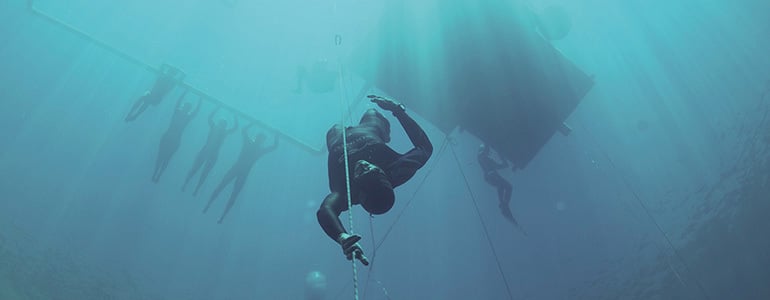
What freedivers can learn from the top of the world
Suunto ambassador and freediver William Trubridge has given his life to the sport of diving as deep into the ocean’s depths as any human can without scuba equipment. But he recently decided to explore the other end of the planet – the heights of the Himayalas. He trekked 300 km, with 10,000 m of vertical ascent. The longest day was 13 hours of hiking. We asked him what he learned at the top of the world.
Why did you go trekking in Nepal? It was mainly to do something together with my father David and brother Sam, as we live in separate parts of the world. We chose the Himalayas, as my father loves the mountains, and neither Sam nor myself have seen those kinds of mountains.
"I think freediving training definitely has a crossover effect to mountain climbing."
Where were you?We trekked to Kanchenjunga base camp in eastern Nepal. Kanchenjunga is the third highest mountain in the world, and one of the holiest. The remoteness of this area means there are few trekkers and even fewer amenities. This is exactly what we wanted.
At 5163 m, the atmosphere is half as dense as at sea level, meaning half the volume of oxygen per breath.Vastly different environment than you’re used to – how was it? It was humbling. I realised just how un-adapted my body is to that kind of world. After 12 years of only freediving training in the water my knees were unacquainted with any kind of impact, and the first day's gruelling descent paid its toll. In fact, all the descents were tough for me. I really enjoyed going uphill because I was able to push myself. You’re used to having a lack of oxygen – how was the higher altitude for you? The altitude wasn't a factor. Our ascent was very gradual, which allowed the body time to adapt. I think freediving training definitely has a crossover effect to mountain climbing by developing haemoglobin oxygen storage in the blood. Freediving training stimulates erythropoiesis, which is the generation of new red blood cells, in order to store and transfer more oxygen. This benefits all hypoxic activities, whether apnea or trekking at altitude. What did you learn? It gave me an appreciation of volumes, and the vastness of the mountains, but also the seas. When looking up at a towering 7,000 m peak and thinking that huge mass could disappear in the huge well that is our planet's oceans it made me marvel at the scale of these environments. What can freedivers learn from trekking or the mountains? Trekking can be a kind of meditation, as the slow pace of changing scenery lulls your mind. It also gives you an appreciation for the 'other end of the spectrum' of our planet's ecosystem, and for the many other various forms that water can take: snow, rain, mist, waterfalls and rivers.
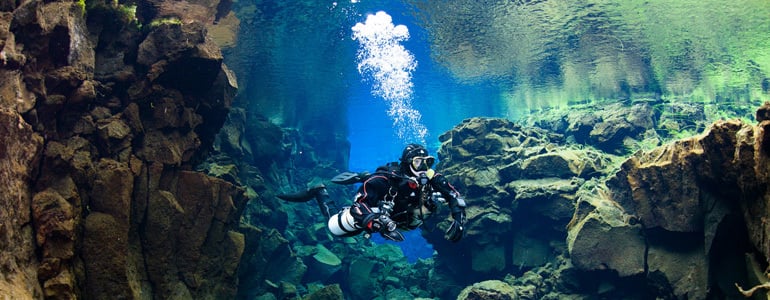
Diving the Shipwrecks of Bell Island
Suunto ambassador and underwater explorer Jill Heinerth dives the world's most incredible locations. Bell Island, Newfoundland is one such site. The video below shows why it's a diver's paradise.
Tell us about the Bell Island and its wrecks.
Bell Island is one of the few locations in North America that was under attack by German forces during the Second World War. In 1942, U-boats raided the island twice, sinking four iron ore carriers and destroying a loading wharf, killing more than 60 men. During the war, the mines on Bell Island, Newfoundland supplied iron ore that accounted for one-third of Canada's steel production. Germany knew that they could interrupt the flow of ore, even temporarily, and Canada's war output could be seriously affected.
Click here to find out more about Jill Heinerth
What drew you to dive there?
I was part of a team documenting the recovery of a sextant from the wreck of the Rose Castle. Rick Stanley, owner of Ocean Quest Adventure Resort, worked for over a year to secure the correct permits and line up provincial conservators to preserve the important artifact that will be eventually be displayed in an extensive museum on Bell Island.
Why is it such an amazing dive location?
Newfoundland is a great destination for the adventurous divers. Today, divers visiting Newfoundland’s rich waters, can dive these remarkable wrecks that have transformed into stunning and colorful reef structures.
Is there more to explore there?
In the summer, divers can also enjoy diving on icebergs and swimming with whales that gather in the area to feed on capelin. I’ve been recently working with other cave divers to document the submerged mines which cover over 100 square kms. This coming season, mine operators hope to open diving activities to qualified cave divers visiting the area. The mine is still filled with all the equipment and artifacts of operations there. Seeing the large equipment, miner’s graffiti and personal items is an interesting opportunity.
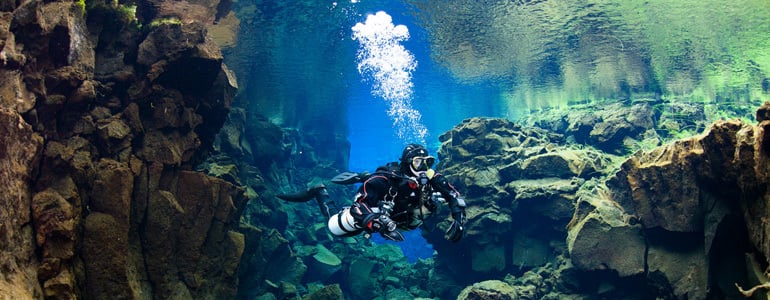
Dancing with Devil Rays
Suunto ambassador Jill Heinerth recently explored dive locations around the Azores islands in the Atlantic Ocean. The destination’s wrecks, megalithic steps and lava caverns blew her mind, but swimming with devil rays was one of the greatest diving experiences of her life.
The devil ray or mobula is species of eagle ray that can grow up to five meters long. They are sometimes called flying rays because of their propensity to breach the ocean surface. They are endangered because of water pollution and bycatch capture.
Underwater explorer and photographer Jill Heinerth swam with about 30 devil rays in open ocean over a sea mount off Santa Maria Island in the Azores. Devil rays visit the area to feed. Jill recounts the experience below.
“As I patiently waited, they seemed to line up in formation and repeatedly moved closer and closer with graceful ease,” she says. “Each followed along the same path arching towards me, sliding sideways for a look and then turning to come even closer. “Hovering over top of me, they would pause while I held my breath as long as I could. Finally I would exhale bubbles from the scuba regulator and the ray would slip away and allow the next one to move over top of me. “It seemed as though they were interested in getting tickled by my stream of bubbles. The dance went on for almost 90 minutes. “It was one of the most spectacular diving experiences of my life."
Press play to watch this beautiful video of that day
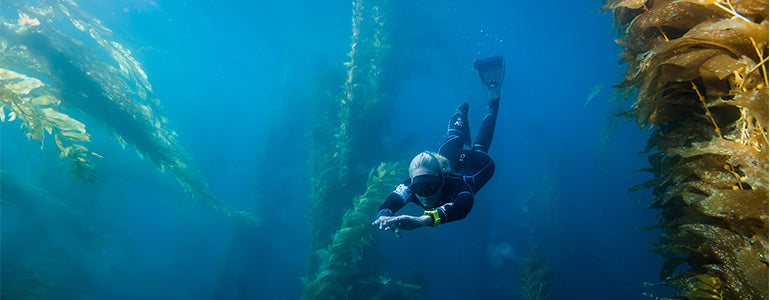
Learning the joy of freediving
You don’t need to be able to hold your breath for minutes to enjoy freediving. Below the Scuba Diver Girls’s Margo Sanchez explains why diving without gear can lead to the best underwater experiences.
Scuba Diver Girls Stephanie Adamson & Margo Sanchez are based in California. © Scuba Diver Girls
Why freedive? There is something very freeing about diving without heavy gear. It is a magical experience when you drop down into the silence of the ocean, but hear the distant chirp of a dolphin or crackling of shrimp. The sport gives myriad benefits over time. Learning the breathing and relaxation techniques teaches you how to relax your mind and body in many situations, both in and out of the water. After practicing, you get more proficient at using those techniques and can challenge yourself to extend the amount of time you can stay under the water.
Press play and watch a harbour seal play with the Scuba Diver Girls How did you get into it? I started out scuba diving and gained my passion for the underwater world with a tank on my back. But it wasn’t until I started diving with sharks that I realized I was not able to get close while I was blowing bubbles loudly on open circuit. I decided to try taking off my tank and diving down with them while holding my breath instead. Once I realized that this brought a whole new dimension to my diving, I decided to take the beginner freediving training with SSI (Scuba Schools International).
“As you swim through the forest, the sun streams through the kelp canopy like stained glass.”
Best freediving experiences? We have been all over the world both scuba and freediving. There are beautiful coral reefs in remote locations of the world that are breathtaking as you skim along the top checking out the little critters that flit in and out. Waking up at dawn in tropical locations to silently slip into the water and then skimming across the surface, looking for what the location has to offer, before finally gliding through its depths is one of the most exciting experiences a diver can have. Click play to see the beauty of our underewater world and the freedom found in exploring itStop, you’re making us jealous! But go on anyway… Probably my favorite place to freedive is right in our back yard in La Jolla California. Dropping down beneath the surface into a thriving kelp forest is an ethereal experience. As you swim through the forest, the sun streams through the kelp canopy like stained glass and a multitude of fish congregate while you swim by. Sometimes you get a visit from a frisky sea lion or a harbor seal tugging on your long fins while other times you swim gracefully alongside a sleek grey shark while it looks into your eye and you hold a common respect for each other through that connection. Most of these sea life encounters can only be experienced on a breath hold and a dive.
“Most of these sea life encounters can only be experienced on a breath hold and a dive.”
© Lesley Grey Alstrand
How do I learn?
Starting out by snorkeling is a great first step. Finding an instructor is next. There will be some out of the water training first for the diver to better understand how freediving impacts the body. For example, what the ‘mammalian diving reflex’ does once in the water, what a diaphragm spasm is and how you should react to it and what the importance of clearing the ears and how often is etc. These principles are important as a foundation so that when you get into the water, you understand what is happening with your body as you dive. Golden safety rules? The most important is always dive with a partner. Understanding your body’s limitations and physical reactions to breath hold is also important. Which is why this is a progressive sport. It is important to learn about your body before progressing to the next depth or time threshold.
© Ashley HauckGreatest challenges? There are two big challenges that may come as a surprise when a new diver begins. First, freediving is very mentally challenging. It’s natural to feel anxiety when holding your breath under water. Learning how to calm your mind is important. The second big challenge that many people face is ear trouble. Your ears are very sensitive and when you dive under the water it’s important to learn and understand not only the technique to clear them effectively, but how often.
“Since I started freediving, I am more relaxed, happy and in shape than I have ever been.”
Anything else? The first goal is to have fun! A freediver should first enjoy the experience. This means taking the training at your own pace and not setting unrealistic goals for yourself in holding your breath or going to greater depths.
© Ashley HauckWhat else do you get from freediving? Not only do the techniques and breath hold skills assist me in enjoying some of the most amazing sea life, but they also help me in my everyday life with stress management. Since I started freediving, I am more relaxed, happy and in shape than I have ever been. The sport brings peace to your life through the silence of the underwater world.
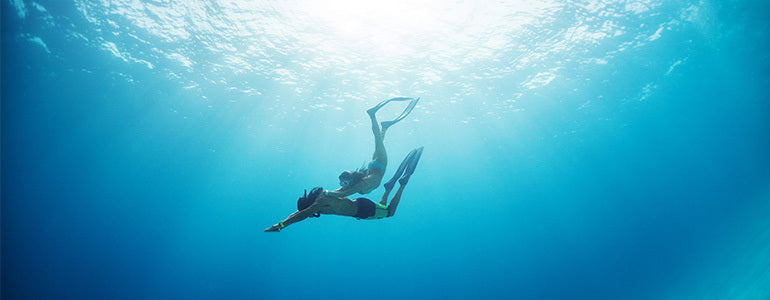
Finding harmony in the deep blue sea
Japanese freediver and former model Tomoka Fukuda has one dream: to explore the world’s oceans as a wandering freediver. One word describes what Tomoka Fukuda loves about freediving. “Harmony,” she says, “between my body, my mind and the ocean. “When I dive in the ocean, I am diving into myself. I can see inside myself clearly. When I have a good dive, I feel that I am a small part of this world where everything is connected.” Tomoka wasn’t always so Zen. Prior to first freediving eight years ago, she worked as a model and ran her own beauty salon. She’s the first to admit it: as a model, she was a little bit crazy – lots of parties, busyness and stress. But then she found freediving. “The ocean has taught me many things,” the 37-year-old says on the phone from Greece, where she is currently training. “You can’t lie to the ocean. It’s like a mirror. I learned that our limitations are only in our mind and you can extend them.”
Click play to watch this video of Tomoka diving with Fernando Stalla
Originally from Japan’s northernmost island Hokkaido, Tomoka’s enduring connection to the ocean began on family holidays to a cousin’s home by the sea. She went from a child splashing around at the beach, to becoming a competitive backstroke swimmer. But her life really changed when she visited Okinawa, Japan’s southernmost island, and tried scuba diving and freediving for the first time. “The ocean was so beautiful that it stunned me,” she says. “I decided to relocate my whole life there so I could be close to it.” There, Tomoka met an experienced spear fisherman who became her mentor. They went freediving every week and he taught her everything he knew about freediving and the underwater world. Before long freediving became more than just a leisure sport. The AIDA Depth World Championship was held in Okinawa in 2010 and Tomoka helped as a safety diver for the competitors. “I saw so many amazing freedivers and I knew I wanted to do that too so I decided then to train seriously.” Just one year later, Tomoka competed in the AIDA Depth World Championship in Kalamata. The following year, during the 2012 Suunto Vertical Blue freediving competition in Dean’s Blue Hole, Tomoka dived to 80 m, realizing a long held goal. That same year, she also won Suunto’s People’s Choice Award for Best Female Newcomer at the AIDA Depth World Championship. And she won second place in the women’s division at the 2015 Suunto Vertical Blue competition. The wandering freediver is also well on the way to fulfilling her dream of freediving all around the world. This year alone she’s plunged into the waters of seven countries. Her favourite locations to date are Greece, the Maldives, the Bahamas, Italy’s Puglia and Egypt’s Dahab. “Before, I wanted everything, now I don’t need anything,” Tomoka says. “I am fulfilled solely by ocean happiness and do not have material desires.
“I just want to dive in the ocean. The ocean is my world.”
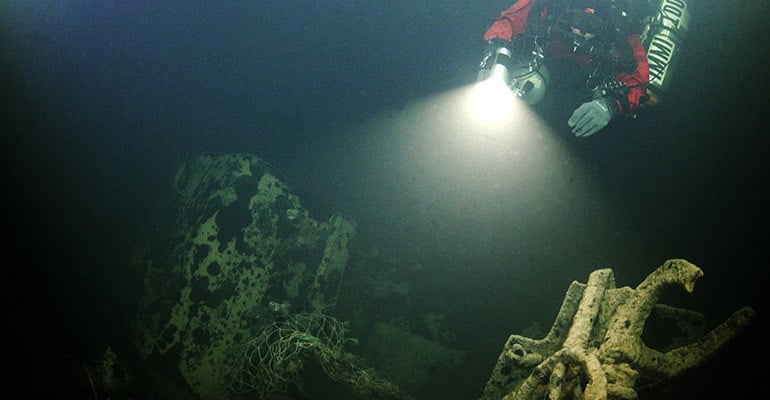
FINDING THE LAST MISSING GERMAN WW2 U-BOAT IN THE GULF OF FINLAND
“For those who love adventure and exploration, the fraction of a second when you realise that you have actually rewritten the history or confirmed something that has only been speculated on before, is an unforgettable moment,” says underwater explorer Immi Wallin.
Immi Wallin and her Subzone team discovered a missing German U-boat off the Estonian coast in August. Here, Wallin tells the story for the first time.
“The secrets of the seas, with its hidden lost ships, do not reveal themselves easily. To find these secrets, you sometimes need perfect weather, plotting information from the archives of sea charts and then checking a mysterious marking on your chart, which you do not remember how and why you put down in the first place.
On August 12th, about a month ago, I went to check a marking on my sea chart with side scan sonar together along with my colleague. The marking had bothered me for some time because I did not remember what it was and it seemed to be next to a mine row and in a patrol area of a still missing German U-boat.
U679’s closed hatch and periscope
U-679 gave a weather report on December 27th 1944 while in the Gulf of Finland. She had rendezvoused at sea with U-637 and U-745 in the evening of December 26th. U-745 had delivered encrypted communication.
On January 9th, Soviet MO-124 detected a submarine four miles northeast of the Pakri lighthouse and dropped eight large and 20 small depth charges. The Germans assumed that MO-124 had sunk U-679, but the Soviets did not believe it because they didn't find any evidence of a destroyed submarine in the area. Nevertheless, the cause for disappearance of U-679 that was recorded in Western literature was depth charge attack by MO-124. The fact that U-679 did not reply to a message sent on January 10th, 1945 supported this theory.
Depth, poor visibility, hydrogen sulphide, hypoxia and trawl nets made the dive a challenge
Back to August 12th 2015. I decided to survey the whole mine row laid in January 1945 that was plotted next to the marking I had on my sea chart. When reaching the marked spot on the chart, something happened on the screen of the side scan sonar. The moment I saw a submarine image appearing on the sonar screen was exactly the fraction of a second that I will remember forever. The image showed a Type 7C German submarine – already recognizable from the image. There was only one that had not been found yet – U-679. That same night the Estonian National Heritage Board was informed about the discovery.
The first dive to U-679 was conducted on September 10th. Due to the depth, 90 m, we needed a flat sea and a team of deep divers, support divers and boat handlers. The aim for the dive was to document the wreck’s condition. The video material was provided to the authorities.
Conditions were good at the surface, but more challenging in the water. There were slight horizontal currents all the way from the surface to the bottom. The most challenging part was the visibility that worsened towards the depths.
We passed several white cloud layers and just about 10 m above the bottom the visibility got very bad and I could smell the hydrogen sulphide typical for a sea bottom with hypoxia. The shape of the submarine’s conning tower became slightly visible in the light we carried with us. The shot line was in the middle of the conning tower, so we decided to shoot video around the conning tower having possibility to find back to the shot line.
U679’s 37mm antiaircraft gun
The video camera, once again, could see much more than our eyes. We could confirm what was visible already on the side scan sonar image. The conning tower was type IV, having 3.7 cm anti-aircraft gun on the lower wintergarten and two 2 cm zwilling anti-aircraft guns on the upper wintergarten. The hatches were closed.
U-679 was lost with all hands, so the wreck is also a war grave for 51 men who lost their lives serving their country. The wreck will be respected as these men’s final resting place and as a historical monument of the war event. U-679 is now under state protection set by Estonian Heritage Board.”
Freedom – The beauty of our underwater world
Experience the beauty of our fragile underwater world with Tomoka Fukuda, Fernando Stalla and others.
Freedom – The beauty of our underwater world

Will Trubridge ready to dive deep in Cyprus
For the last two weeks he’s been adjusting to the different water conditions in Cyprus, the location of the AIDA Depth Diving World Championship happening this weekend. Is world champion freediver William Trubridge now ready to battle his great rival Alexey Molchanov?
When Will Trubridge arrived in Cyprus two weeks ago to prepare for the AIDA Depth Diving World Championship, he got a surprise. He discovered he’s about 300g lighter in the water of Cyprus than in the Caribbean, his home turf.
“The waters of Cyprus are the saltiest in the Mediterranean,” Will explains. Saltier water means denser water, which is made denser again due to the water in Cyprus being cooler than the Caribbean. “This means I am more buoyant than I am in Dean's Blue Hole at the same depth,” Will says. “This makes my descents a lot longer here, 14 seconds longer for the same depth.”During one recent dive, Will was 20 seconds slower than he would have been in the Caribbean and, as a result, he had his first surface blackout since April. But, after some mathematical calculations – something Will enjoys – he worked out that diving with an extra 300g lead weight on his neck balances out his extra buoyancy – problem solved. He’s now ready to battle his great rival, Russian freediver Alexy Molchanov.
Click here to read more about Will Trubridge and his love of the ocean
Alexy has just arrived in Cyprus after training for some time in Croatia where the water condition is similar to Cyprus. “I’m sure Alexy is going to give me a good run for my money,” Will says. “We get on very well, but we definitely want to beat each other.”Despite wishing he had more time to train before the competition this weekend, Will’s confident he will do well in FIM and CNF, the Free Immersion and Constant Weight Without Fins disciplines of freediving.“My fundamental goal is to do three clean dives,” Will says. “If I do that, then I’m guaranteed three medals. I would like to win gold if possible.”
Aside from winning, Will’s most looking forward to seeing how he responds to the extra pressure of diving in a high profile competition. “In training, my dives are discovery of my potential,” he says. “In competition it’s more about staying focused and steady in mind and stepping up to the plate to win under tough psychological conditions. “In most other sports, the adrenalin you get from performing in front of spectators and media can be used to your advantage, whereas in freediving anything that lifts your heart rate isn’t helpful. “That’s the big psychological test of competing at this level.”
The AIDA Depth Diving World Championship is from September 11 to September 20. Stay tuned for the competition results!




























































